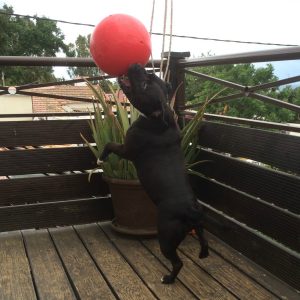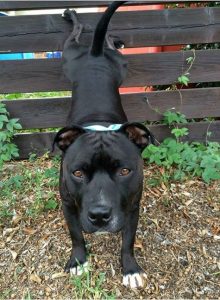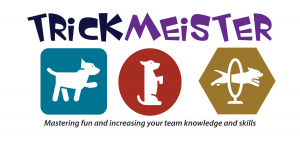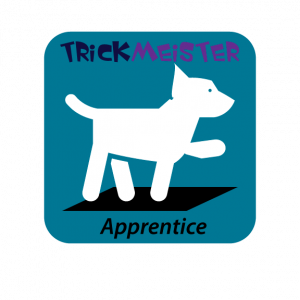Many of you will know that I think all training should be fun but science-based. I teach all behaviors as ‘tricks’ because I believe that, in doing so, we set up both trainer and learner for success. Whether teaching a ‘stay’, a ‘recall’, a ‘spin’ or a fun routine, teaching behaviors as ‘tricks’ sets the theme – learning should be playful! I therefore loved the fact that at a recent seminar I attended, much emphasis was placed on play. RAGE, FEAR, GRIEF/PANIC (punishing) and SEEKING, LUST, CARE and PLAY (rewarding/reinforcing) – American neuroscientist and author, Jaak Panksepp’s primary-process affective emotional systems of the brain – were referred to several times with an emphasis on play being essential for healthy brain development and for learning. When feeling playful one can find solutions that are not available when afraid!
In the TrickMeister – Mastering fun and increasing your team knowledge and skills Course curriculum I not only place an emphasis on play but also on making sure that we break down each behavior into easily achievable criteria to set up the learner for success and achieve minimal or ‘micro’ error learning. Trainer Kay Laurence calls this ‘micro-slicing’ and I also use Kay’s terminology and practice of micro-shaping behaviors.

Training can be both science-based and fun
I also love to teach learners a wide repertoire of behaviors, all successfully learned without incurring lots of errors. Micro-shaping behaviors means that only micro-extinction occurs as we build in each new approximation to the final behavior. Micro-errors do not destroy confidence. Our learners need ‘puzzle moments’ (Kay Laurence) and the ability to explore their options. These ‘micro-errors’ are actually just information. Teaching with too large an increase in criteria leads to an extinction process that can be stressful, frustrating and punitive for the learner.
The failure of response to get reinforced leads not only to operant extinction but also to a reaction commonly spoken of as frustration or rage. – Dr. Jesús Rosales-Ruiz.
We also need to bear in mind that when resurgence occurs we fall back on previously learned behaviors. We should always strive to build from a clear base position. This foundation behavior will be the behavior our learner returns to when unsure of how to proceed. If our base behaviors are taught without errors, are well practiced, and build confidence and trust in the learning process, we really are setting up our learners for success. The more fun-filled, ‘thoughtfully’ taught, positively reinforced behaviors our learners know, the less space there will be for our learners to fall back on behaviors we would rather not see.

Trick Dog Champion Jambo demonstrates his handstand – but has not been trained to do a freestanding handstand as this risks placing undue pressure on his joints
I have previously spoken out about training behaviors just because they may look good (impressive) to the spectator. I, for example, was once questioned as to why I haven’t taught my Trick Dog Champion Jambo to do a free-standing handstand. My answer was that it isn’t a suitable ‘trick’ for him. Yes, I teach some behaviors just for fun but I always endeavor to never teach anything that could be detrimental to the physical or mental well-being of my learner. I have also been criticized for advising people not to do anything that would place undue stress on a learner’s joints. Tricks that involve high or repetetive jumping, for example, are not suitable for young dogs whose growth plates haven’t fused, Nor are they suitable for more elderly dogs. I do not believe in teaching any behavior just for the sake of teaching it and I would rather keep my canine partner free from injury than risk his well-being just for the sake of showing off an ‘impressive trick’. Teaching and learning complex behaviors and concepts show much more skill than teaching a pet dog to jump from a great height!
The training methods we choose evolve from our underlying beliefs and principles. – Alexandra Kurland.
Positive reinforcement is very powerful. Just because we can teach something doesn’t mean that we should.
I will end with some quotations.
Dr. Jesús Rosales-Ruiz: “Build the behavior with what you want, so when you use extinction, or it occurs, you fall back on wanted behaviors.”
Kay Laurence: “Just because you can, doesn’t mean you should,” and, quoting Chris Bond: “It’s not about training impressive behaviors, it’s about impressive training of behaviors.”
Alexandra Kurland: “For every step you include in your training, there is always a smaller step you can break the behavior down into. Don’t get louder. Get quieter – Take smaller steps!”
Louise Stapleton-Frappell B.A. HONS. PCT-A. CAP3. CTDI. Dn-FSG is the author and instructor of TrickMeister – Mastering fun and increasing your team knowledge and skills: A unique program aimed at increasing the knowledge and training skills of both dog guardians and pet professionals. The aim of the TrickMeister courses is to teach the science behind the training as well as all the skills needed to train a pet dog, with a big emphasis on enjoyment. We firmly believe that all training should be fun but knowledge based. We also believe in setting the learner up for success. This applies both to our human learners and their canine buddies!
Sign up for the TrickMeister Apprentice Course here.
Why not have some fun and earn your TrickMeister Title?
TrickMeister – Mastering Fun with Your Dog Titles are totally unique as they don’t just concentrate on the finished tricks, they judge how the trick is trained and executed. The TrickMeister team Titles put the handler’s training skills to the test! We firmly believe that all training should be fun but knowledge based. We also believe in setting the learner up for success. The TrickMeister Titles look at the handler’s training “mechanics” and communication skills – the ability to clearly and appropriately cue, mark and reinforce behaviors as well as the skills needed to teach behaviors using a range of different training methods. TrickMeisters pay particular attention to their learner’s demeanor – TrickMeister Titles are only awarded when it is clear that the learner is a willing, enthusiastic partner in the training process!



Sign up today and become a TrickMeister!


